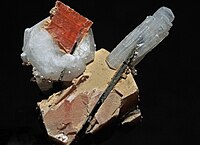
Photo from wikipedia
This work investigated characteristics of Al2O3/native oxide/n-GaN MOS capacitors by post-metallization annealing (PMA). A native oxide interlayer which composed of e- and γ-Ga2O3 phases (Native oxide) and the reduced amount… Click to show full abstract
This work investigated characteristics of Al2O3/native oxide/n-GaN MOS capacitors by post-metallization annealing (PMA). A native oxide interlayer which composed of e- and γ-Ga2O3 phases (Native oxide) and the reduced amount of one (Reduced) on n-GaN were prepared by cleaning only a sulfuric acid peroxide mixture (SPM) and both SPM and buffered hydrofluoric acid, respectively. The effect of trimethylaluminum precursor on removal of a native oxide layer was not observed during Al2O3 deposition using atomic layer deposition. An as-grown capacitor (Native oxide) exhibited a small flatband voltage (V fb) hysteresis of ~30 mV and a large frequency dispersion, suggesting that the initial growth of the Al2O3 resulted in the formation of electrical defects on the GaN surface. Both the V fb hysteresis and frequency dispersion were drastically improved by PMA of the device at 300 °C. The positive fixed charge values (Q IL) estimated from the relationships between capacitance equivalent thickness and V fb were +6.1 × 1012 and +0.4–1.0 × 1012 cm−2 for as-grown and PMA-processed capacitors in the PMA temperature range of 300 °C–600 °C, respectively. The interface state density (D it) determined using a conductance method was also significantly reduced (by an order of magnitude) after PMA processing at 300 °C. These trends in the Q IL and D it data were observed in both the Native oxide and Reduced capacitors, indicating that this interlayer does not greatly affect fixed charge generation at the Al2O3/native oxide and Al2O3/modified native oxide interfaces. As a result, two types of treatments result in insignificant difference in the electrical properties of the capacitors.
Journal Title: Semiconductor Science and Technology
Year Published: 2019
Link to full text (if available)
Share on Social Media: Sign Up to like & get
recommendations!